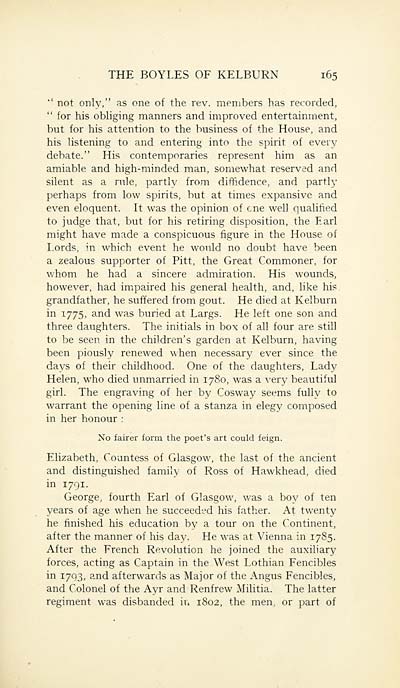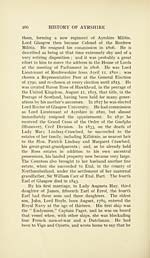Download files
Complete book:
Individual page:
Thumbnail gallery: Grid view | List view

THE BOYLES OF KELBURN 165
'' not only," as one of the rev. members has recorded,
" for his obliging manners and improved entertainment,
but for his attention to the business of the House, and
his listening to and entering into the spirit of every
debate." His contemporaries represent him as an
amiable and high-minded man, somewhat reserved and
silent as a rule, partly from diffidence, and partly
perhaps from low spirits, but at times expansive and
even eloquent. It was the opinion of one well qualified
to judge that, but for his retiring disposition, the Earl
might have made a conspicuous figure in the House of
Lords, in which event he would no doubt have been
a zealous supporter of Pitt, the Great Commoner, for
whom he had a sincere admiration. His wounds,
however, had impaired his general health, and, like his
grandfather, he suffered from gout. He died at Kelburn
in 1775, and was buried at Largs. He left one son and
three daughters. The initials in box of all four are still
to be seen in the children's garden at Kelburn, having
been piously renewed when necessary ever since the
days of their childhood. One of the daughters, Lady
Helen, who died unmarried in 1780, was a very beautiful
girl. The engraving of her by Cosway seems fully to
warrant the opening line of a stanza in elegy composed
in her honour :
No fairer form the poet's art could feign.
Elizabeth, Countess of Glasgow, the last of the ancient
and distinguished family of Ross of Hawkhead, died
in 1791.
George, fourth Earl of Glasgow, was a boy of ten
years of age when he succeeded his father. At twenty
he finished his education by a tour on the Continent,
after the manner of his day. He was at Vienna in 1785.
After the French Revolution he joined the auxiliary
forces, acting as Captain in the West Lothian Fencibles
in 1703, and afterwards as Major of the Angus Fencibles,
and Colonel of thie Ayr and Renfrew Militia. The latter
regiment was disbanded in 1802, the men. or part of
'' not only," as one of the rev. members has recorded,
" for his obliging manners and improved entertainment,
but for his attention to the business of the House, and
his listening to and entering into the spirit of every
debate." His contemporaries represent him as an
amiable and high-minded man, somewhat reserved and
silent as a rule, partly from diffidence, and partly
perhaps from low spirits, but at times expansive and
even eloquent. It was the opinion of one well qualified
to judge that, but for his retiring disposition, the Earl
might have made a conspicuous figure in the House of
Lords, in which event he would no doubt have been
a zealous supporter of Pitt, the Great Commoner, for
whom he had a sincere admiration. His wounds,
however, had impaired his general health, and, like his
grandfather, he suffered from gout. He died at Kelburn
in 1775, and was buried at Largs. He left one son and
three daughters. The initials in box of all four are still
to be seen in the children's garden at Kelburn, having
been piously renewed when necessary ever since the
days of their childhood. One of the daughters, Lady
Helen, who died unmarried in 1780, was a very beautiful
girl. The engraving of her by Cosway seems fully to
warrant the opening line of a stanza in elegy composed
in her honour :
No fairer form the poet's art could feign.
Elizabeth, Countess of Glasgow, the last of the ancient
and distinguished family of Ross of Hawkhead, died
in 1791.
George, fourth Earl of Glasgow, was a boy of ten
years of age when he succeeded his father. At twenty
he finished his education by a tour on the Continent,
after the manner of his day. He was at Vienna in 1785.
After the French Revolution he joined the auxiliary
forces, acting as Captain in the West Lothian Fencibles
in 1703, and afterwards as Major of the Angus Fencibles,
and Colonel of thie Ayr and Renfrew Militia. The latter
regiment was disbanded in 1802, the men. or part of
Set display mode to:
![]() Universal Viewer |
Universal Viewer | ![]() Mirador |
Large image | Transcription
Mirador |
Large image | Transcription
Images and transcriptions on this page, including medium image downloads, may be used under the Creative Commons Attribution 4.0 International Licence unless otherwise stated. ![]()
| Histories of Scottish families > Ayrshire > Volume 2 > (175) Page 165 |
|---|
| Permanent URL | https://digital.nls.uk/95191198 |
|---|
| Attribution and copyright: |
|
|---|---|
| Description | A selection of almost 400 printed items relating to the history of Scottish families, mostly dating from the 19th and early 20th centuries. Includes memoirs, genealogies and clan histories, with a few produced by emigrant families. The earliest family history goes back to AD 916. |
|---|

